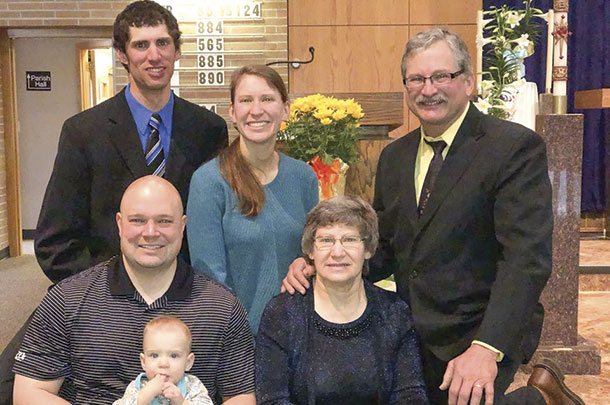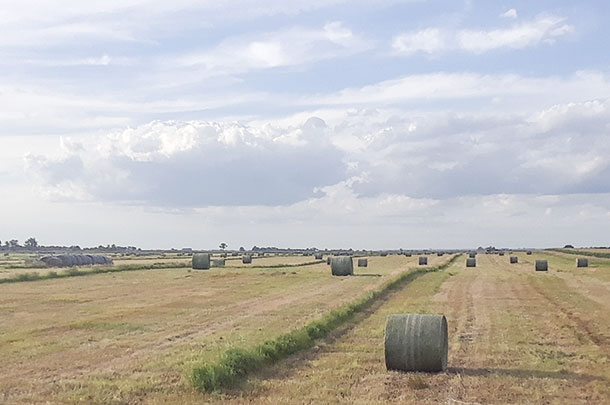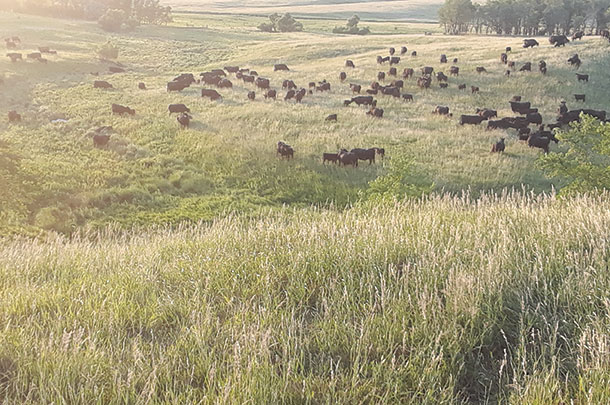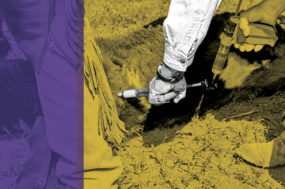Before long, those reins will also be in the hands of 32-year-old fifth-generation cattleman Lee Kopriva.
 “Lee and I farm separately, together. He’s got his own land, his own machinery, his own livestock. But we work together for management reasons. We maybe only have one heifer pasture because we don’t need to do it twice. But we operate together, separately. We kind of neighbor together. It’s working for me because I’m getting kind of old,” Jim says with a chuckle.
“Lee and I farm separately, together. He’s got his own land, his own machinery, his own livestock. But we work together for management reasons. We maybe only have one heifer pasture because we don’t need to do it twice. But we operate together, separately. We kind of neighbor together. It’s working for me because I’m getting kind of old,” Jim says with a chuckle.
Jim has an unwavering passion for a profession that isn’t for everyone. However, Jim’s energy for the beef industry might be surpassed slightly by his spark for conserving the land he’s responsible for.
Jim often emphasizes how it’s a matter of working with the land rather than against it. Kopriva Angus has found an ideal balance of farming and ranching, and has been widely recognized for their efforts including the 2008 Grass Management Award, 2012 Leopold Conservation Award (South Dakota) and, most recently, the 2015 Region VII Environmental Stewardship Award. Yet Jim is still humbled by the accolades his operation has received during his tenure.
Land management
It’s not about the awards; rather the philosophy Kopriva Angus has established. It’s a harmonious give-and-take operation that spends as much energy on raising cattle as it does on the 3,000 acres in northeast South Dakota sustaining them.
“Our big thing is about conservation,” Jim says. “We’re into improving the resources, not depleting it. We don’t want to be miners; we want to be stewards. And we don’t necessarily go with the idea of sustainability because that kind of says you’re not improving. That’s kind of a ... to me, that implies a stalemate.”
Jim’s various land management practices pursue a goal of not desecrating the resources. Such practices, Jim notes, include no-till, rotational grazing, keeping all the precipitation on the property and maintaining native grass pastures.

“We now know how to regenerate the soil and how to improve it as we use it,” Jim says. “We can improve water infiltration; we can improve fertility. We can improve the water- holding capacity, the organic matter and so on. That’s well within reach.
“Of course, we have to be profitable, or we can’t stay. But we can be profitable and improve the resources. That’s the parameters in which we operate.”
Serving on the board of South Dakota Grassland Coalition and South Dakota Soil Health Coalition in addition to using their awards as a platform, Jim has devoted considerable energy to encouraging conversations among cattle producers about improving land resources.
“It’s not like what we do here on our place is going to change the planet, but it’s the idea of trying to teach people and cause a lot of people to adopt a different mentality on how to take care of the resources,” Jim surmises.
Genetics
While the Koprivas’ land management has won them accolades, they have developed animals that work for them and their customers. Their management recipe in raising cattle isn’t rocket science per se, but it solidified the operation for years to come.
“We may not have the real hot genetics, but we have the genetics that are where we think we need to go to design the right kind of cattle to convert grass into protein,” Lee Kopriva says. “If you can find people that really appreciate your genetics, they’ll come back.”
After a gradual shift into seedstock pioneered by Jim’s first bull sale in 1986, Kopriva Angus now runs 95 percent registered cows and approximately 5 percent commercial. They run a tight genetic ship utilizing various breeding technologies.
“We have a pretty intense A.I. program,” Lee notes. “There are quite a few years [we were] putting quite a few embryos, [but] now we’ve backed off putting in embryos and moved to trying to use more artificial insemination.
We’ll A.I. heifers and then A.I. the group of mature cows – tighten up our calving window. And so cows that don’t use our calving window, they get sold as bred cows. What we’ve done is: We’ll keep more heifers and sell bred cows. We’re trying to use our most current and precious genetics for our heifers.”
The genetics Kopriva Angus aims to propagate focuses heavily on forage feed efficiency.
“We’re getting to the point where the cows are herded really young, fairly young. We’ve had a chance to replicate our genetics really quickly, and we’re trying to pinpoint on the genetics we really believe in,” Lee says. “We’ll usually retain quite a few heifers and sell some replacement heifers that would be really good for people to build a herd.”
Their annual bull sale in May sells the top 25 percent of the developed bull calf crop. The Koprivas are not shy to adopt various genetic technologies as appropriate for their herds.
“We try to stay really current on technology with the genetics,” Lee notes. “We’ll take birthweight, weaning weight, yearling weight data. We’ll ultrasound at yearling time for percent IMF (intramuscular fat), for ribeye, for back fat and rump fat. Then we’ll also take blood sample or a tissue sample and send it in for DNA analysis and for current verification. We use several different genetic profile companies for the HD50K or the I50K.”

Noting the competitive landscape of the seedstock business, especially in the northern Great Plains, Lee approaches management decisions with consideration for what will work today and tomorrow.
“We’re trying to produce genetic splitters that are going to be functional and that are going to work for people, and are going to help build us a reputation that we’re in the business to stay.”
The next generation
Lee aims to keep the Koprivas’ future on the current trajectory by continually refining and tweaking what is and is not working, with specific emphasis on the smaller details.
“I see our operation maybe not growing in acres or numbers of head, but using more management on every acre or on every head. I see smaller, incremental management decisions to increase profitability and using different management techniques on our grazing management to increase our steering capacity but also make our grazing acres better as we’re increasing our returns capacity.”
Both Lee and Jim note their gates are open for anyone who wants to stop by to chat or learn about their operation.
“We enjoy having people come tour, see cows, see grass, talk about some of our different production settings we use,” says Lee. “It’s good because not only [are] they probably learning something, but usually we’ll learn something from other people, too.”
While the Koprivas recognize their place in the world pales in comparison to the full breadth of the global land and resource issues we are facing, they work to keep an eye on the bigger picture, too.
“There’s no more land. When we’ve destroyed this, we’re done,” Jim concludes. “So we’d better learn how to take care of what we’ve got. And what we’ve got is a whole bunch of life in that soil. And it’s a living, breathing community. It does so much. It’s so resilient. Yes, it’s minerals, and it’s water, but it’s life. A teaspoon full of good soil has more life in it than the human population of the planet Earth. It’s just incredible.” ![]()
PHOTO 1: Kopriva Angus A.I. young heifers in June and July after they have turned out to grass. Utilizing pasture and portable freestanding panel corrals, they capitalize on the opportunity to work and precondition calves.
PHOTO 2: Back row – Lee Kopriva, Angela Kopriva Brown, Jim Kopriva; front row – Kerry Brown holding Ivy Brown, Karen Kopriva.
PHOTO 3: Recently, some of the Kopriva cropland acres were seeded to native grasses consisting of big bluestem, indiangrass, side oats grama and switchgrass interseeded with legumes consisting of cicer milk vetch, falcata and alfalfa. They often leave 2- to 3-foot strips uncut the entire length of fields to serve as snow fence.
PHOTO 4: Kopriva Angus utilizes rotational grazing and various other land conservation practices to optimize resources. Photos provided by the Kopriva family.
Danielle Schlegel is a freelance writer based in Whitewood, South Dakota.








